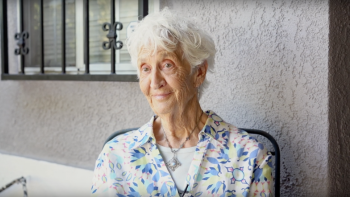Aging in Place FAQ
Habitat for Humanity works to help older adults age at home and in communities of their choice through our Aging in Place program. Local Habitat affiliates collaborate with human services organizations to evaluate individual needs and provide home repairs, modifications and community services specific to each homeowner’s lifestyle to preserve their home and their independence.
Check out common questions about our work below, and find your local affiliate to learn about aging in place work in your area.
What is aging in place?
-
The U.S. Centers for Disease Control and Prevention defines aging in place as “the ability to live in one’s own home and community safely, independently and comfortably, regardless of age, income or ability level.”
Habitat’s Aging in Place program enables low-income older adults to age safely in their homes and community.
How does Habitat’s Housing Plus model support aging in place?
-
Habitat works in local communities across the United States to support older adults that wish to remain in their homes and in their communities as they age.
We innovated a holistic model — called Housing Plus — which not only provides individualized critical home repairs but also connects homeowners to needed community-based support services to remain in their homes.
A Habitat construction specialist conducts a home repair assessment to determine modifications that are specific to each homeowner. Houses often need critical repairs and modifications to accommodate the physical limitations of aging. Habitat performs home repairs and modifications to ensure homes are safe and accessible.
This is paired with a functional assessment where a human or health services professional speaks with homeowners about their needs and activities of daily living. Habitat partners with and connects older adults with community-based support services to meet their needs, such as help with food or cleaning, allowing older homeowners to maintain a healthy lifestyle and live independently.
Our Housing Plus model allows older adults to age at home with better health outcomes.
How can older adults get help to age in their homes?
-
Habitat has local Habitat affiliates throughout the country. Our affiliates work with low-income older adults in their communities and provide personalized home repair and social services.
You can search for your local Habitat and contact them directly about aging in place programs in your area.
What are the age and income qualifications to receive Habitat’s Aging in Place services?
-
Age and income qualifications are determined by the local Habitat affiliates across the country and sometimes vary. In general, Habitat seeks to partner with those who are considered low-income. The age for receiving Aging in Place services is typically early- to mid-60s and older. Contact your local Habitat affiliate for specifics on their age and income qualifications.
What kind of home repairs and modifications does Habitat perform?
-
There are many risks for injury to older adults and older adults with disabilities in the common household. These have a big impact on their capability to successfully age in place. With an eye to accessibility, Habitat customizes home repairs and modifications based on individual needs.
We alleviate home repair and accessibility issues both inside and outside the homes, though some affiliates only do outside repairs and some only do repairs inside the home.
Some examples of our repairs and modifications:
Interior home modifications: safety bars, improved lighting, floor repairs, ADA-compliant toilet and sink, walk-in shower stall to minimize risk of falls, energy efficiency projects such as new doors and windows.
Exterior home modifications: ramp at entrances, new roof, new siding and paint, porch repairs.
What kind of community-based support services does Habitat connect older homeowners to?
-
Our local Habitat affiliates partner with community-based social organizations to provide a range of support to older homeowners. Social services include helping older adults with grocery shopping, bringing prepared meals, providing transportation for doctor visits, walking a dog and running errands.
How does Habitat’s Housing Plus model improve health outcomes?
-
Advancing both housing and health equity is central to Habitat’s work, and we do this by pairing home repairs with the expertise and assistance of health care and human services professionals.
This integrated housing and health support is key to improving the quality of life of older residents. Our evidence-based aging in place solutions increase independent living, reduce symptoms of depression and improve motivation — leading to reduced medical costs while also lessening the burden on caretakers and families.
Habitat has also incorporated the evidence-based CAPABLE model developed by John Hopkins School of Nursing to support aging in place services for low-income adults. CAPABLE combines occupational and physical therapy with home repair and modification services.
You can read our detailed case studies and the profound outcomes of our work with older adults.
What types of partnerships are needed to implement health and housing initiatives to drive better health outcomes among older adults?
-
Local Habitat affiliates are implementing a wide range of innovative partnerships to support the well-being of older adults. We understand wellness within a social determinants of health framework, and to that end, partnerships with agencies across sectors are beneficial to providing holistic support. Examples of partnerships include but are not limited to: the local Area Agency on Aging, health care professionals, social services, financial supports, employment agencies, and legal or educational organizations.
How can other housing organizations pair home repairs with health for older adults?
-
Our resources hub provides comprehensive guides, strategies and data for other housing organizations to learn about and implement Habitat’s evidence-based solutions that integrate housing and health support.
Our Bridging the Gap guide breaks down Aging in Place strategies and the CAPABLE model into clear and explicit steps. This guide helps housing organizations 1) identify, develop and sustain a partnership with the health care sector and 2) carry out the program in collaboration with partners with practical recommendations, templates and timelines.
Has COVID-19 impacted Habitat’s aging in place work?
-
We are actively working on home repairs and modifications and partnering with local social services to continue to support older homeowners.
Even at the peak of COVID with CDC guidelines in effect, we came up with innovative ways to serve older adults while ensuring their safety and well-being.
Local Habitat affiliates began making phone calls to ask older adults how they were doing and what they needed. From these inquiries, affiliates started doorstep delivery services and bringing supplies such as food, water, toilet paper, puzzle books and seeds to help with isolation. Some Habitat local affiliates created virtual home maintenance tutorials and posted them on YouTube.
How can I reach Habitat’s Aging in Place services?
-
Contact your local Habitat affiliate to see if they offer aging in place services for your area.


